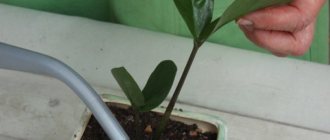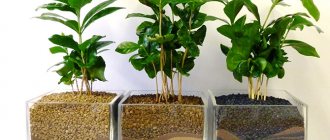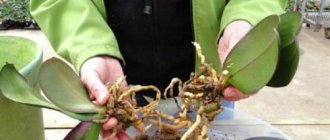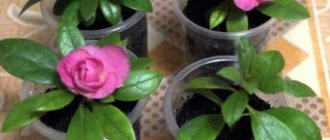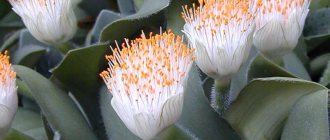Azalea is an amazingly beautiful perennial flower, which is especially interesting because it can bloom in late winter - early spring.
But, meanwhile, this is a houseplant that sensitively reacts to the slightest manifestations of uncomfortable care conditions. Therefore, achieving ideal growth and annual flowering can be difficult. Dear readers! For you, we have created communities on social networks in which useful articles and interesting ideas are published several times a day! Subscribe and receive useful content in a convenient format!
How to choose the right plant?
Tips for choosing Azaleas are about the same as for buying most indoor plants:
- It is preferable to choose a flower on which the first buds have just appeared. It is worth adhering to this rule first of all, since the plant in any case experiences stress when moving from its usual environment. But it was noticed that not in a blooming state, Azalea quickly adapts to new conditions.
- It is recommended to evaluate the external condition of the bush. To do this, it should be carefully tilted. If there are fading or even dry leaves at the base, then it is obvious that such an Azalea grew in an uncomfortable place. There is a risk that she will not survive the move and will quickly wither away.
Azalea in a pot
If you purchase a plant that is already flowering, then the only recommendation is not to try to immediately transplant it into a new pot. It is better to wait until the flowering ends or at least its peak. Otherwise, there will be very little chance of successful survival of such a magnificent flower.
Landing, transplant
Many gardeners believe that it is better to buy a plant with a closed root system; such a flower will take root faster when planted. Some gardeners prefer to shake off the old lump of earth and soak the roots of the flower in a growth stimulator. Both methods of planting can be done if you take into account the general rules:
- It is better to buy a plant in specialized stores. When purchasing, inspect the plant, make sure that the leaves look healthy and are not affected by pests. The flower stem is without lesions or scratches, hard and dense. If possible, remove the plants from the pot and inspect the roots: a healthy root system is light in color.
- Having brought the flower home, put it in the bathroom for a day, let the plant adapt to the microclimate. After two days, place the flower on the windowsill, and only after 3-5 days can you start planting.
- When planting azaleas in a new pot, use specialized potting soil.
- The day before planting, water the plant with Kornevin, this will reduce stress during replanting and ensure rapid establishment of the flower in new conditions.
- It is better to plant the plant before or after flowering; if you plant a flowering rhododendron, there is a possibility of buds dropping.
- The container for planting azaleas should be 2-3 cm larger than the diameter of the earthen ball. You can’t plant a plant right away in a huge pot, this will lead to a stressful state and the flower will start to hurt. Fill with soil, water and leave for a day. Planting (transplantation) is carried out only the next day.
- When planting (transplanting, or transshipping) azaleas, make sure that there are no voids left around the roots of the plant. Press the soil onto the roots with care so as not to damage the fragile roots. After planting, water.
- After planting, it is better to place the plant in a cool, shady place. After 5-7 days, the flowerpot with azalea can be placed on the windowsill.
Caring for Azalea after purchase
If you follow all the rules, namely, purchase an Azalea with barely visible buds, then it is better not to delay replanting it in a new permanent pot. In the future, you can adhere to the rules of transplanting young bushes into larger containers every year, and grown plants - every 2-3 years.
After the first preparations, all that remains is to find the ideal location for Azalea and try to avoid sudden changes in temperature, humidity and light.
Growing conditions
Incomparable and abundant flowering - that's all about Azalea. It is even more pleasant because it comes very early, at the end of February - beginning of March, when winter in most parts of Russia does not even think of letting up. But in order to achieve the appearance of beautiful flowers, you will have to try.
Azalea is a very demanding houseplant. Even minor temperature fluctuations or failure to comply with the frequency of watering can lead to disruption of flowering rhythms, and sometimes even destroy the flower.
Temperature
Azalea notices temperature fluctuations of even 5-10°C. The main feature is that this flower does not like heat at all. During flowering, for example, it is not recommended to place the pot in a place where the air heats up above +18-20 C. Otherwise, even if it is possible to achieve flowering, it will most likely be fleeting and dull.
Optimal temperature for azaleas
Advice! Experienced gardeners recommend choosing a permanent place for Azaleas between two glasses - one will block access to cold air from the street, the other will block access to too warm air from the room. A balcony or veranda is best.
Another feature of this flower is that when the buds appear, it is important to reduce the air temperature even more, to about +12 °C. The upper limit is +18 °C.
In the summer, when it is very hot outside, to reduce stress, it is generally recommended to move the plant to a room where there is air conditioning (but not under direct flows of cold air).
Air humidity
The natural habitat of some varieties of Azalea is the humid tropics. This means that the plant loves high humidity, and this requirement should be strictly observed.
Attention! Particular attention should be paid to moisturizing the flower during the heating season, because hot radiators dry out the air greatly.
Azalea loves high humidity
, but you have to walk a fine line. Azalea is very capricious, so it will react equally poorly to both excessive waterlogging and excessively dry soil in a pot.
In general, you should have a regular sprayer on hand, with which you can give Azalea a light shower with cool water at least once a day. But don't forget about one more feature.
If the plant is blooming, then such procedures should be canceled, because droplets of water falling on the petals will lead to the formation of dark spots. To avoid this, during flowering it is better to simply place containers of water next to the pot, which will gradually evaporate.
Advice! You should avoid the popular misconception that to cool your azalea, you can try periodically placing pieces of ice on the surface of the soil. The root system of the plant in such conditions will be stressed and rot.
Benefits and harms
- First of all, her appearance alone can lift a person’s mood. In addition, it is believed that people who grow azaleas rarely experience depression.
- The plant purifies the air and brings pleasant floral freshness to the room.
- The flower also has medicinal properties. If a person has barley, then you need to apply a plant petal to it, after which it will soon go away.
The harm of azalea lies in the fact that its leaves cannot be eaten. If a person does eat the leaf, his heart rhythm will be disturbed, and intestinal colic will begin. Therefore, you need to ensure that children and pets do not eat its leaves.
It also tends to saturate the air with a strong and persistent aroma during flowering, which can cause headaches and allergies in the form of spots on the skin.
In addition, rhododendron can be used to make an invigorating and healing tea. Read about how to do this correctly, as well as the benefits and harms of the drink here.
Lighting
The main feature of Azalea lighting is due to the fact that it does not like heat. In its natural environment, it thrives in shady places where there is enough light, but where direct sunlight simply cannot penetrate.
Azalea loves light, but can't stand heat
Therefore, it is desirable to recreate the same conditions in an artificial environment.
- It is necessary to find a place where there will be enough light, but where the sun will either not look at all, or only hit in the morning or evening hours.
- The same can be said about those situations when Azalea is taken out into the open air. For example, at the dacha, the plant can be left in a shaded place under the trees in the garden, where the aggressive midday sun will not reach.
- At the same time, Azalea will not have enough light in October-November, when the buds of future flowers are set. Then you can’t do without fluorescent lamps.
We can say that Azalea is demanding in terms of lighting and is most capricious in this aspect. Therefore, finding a suitable place can be problematic, but it must be done.
Choosing a place to put it
Azalea on a table in the back of the room
When the question of choosing a place for Azalea arises, the intensity of sunlight should be put first, and only then the temperature.
The flower will feel good on windowsills where there is little sun. For example, windows facing west or east would be an ideal option. Usually the rays of the rising or setting sun cannot harm the delicate leaves of the plant.
You'll also have to think about temperature. It is true that even a slight discomfort that an Azalea will experience due to too high or too low a temperature will definitely lead to less than ideal and less long-lasting blooms.
Therefore, it is better to give preference to well-ventilated, shady rooms. It is very good if there is air conditioning in the room.
The balcony is also well suited for this heat-loving flower. But only if it does not face the south side.
Azalea on the windowsill
What does it look like in the interior?
Azalea belongs to the genus Rhododendron, which literally translates as “rose tree”. This is the distinctive feature of Azaleas - bright flowers of pink or red.
Externally, this plant is a neat bush that rarely exceeds 50 centimeters in height. Because Azaleas have very small leaves, they are almost invisible when the flowers bloom, occupying most of the plant's volume.
Undoubtedly, Azaleas will decorate a balcony or a not very hot window sill, because during their flowering season, when there is snow outside, they will remind you of the imminent approach of the long-awaited spring.
Plant varieties
Azaleas belong to the genus Rhododendron. Among the plant forms, there are often varieties from 0.5 m to 3 meters in height, with different leaf shapes, petal colors and life cycles, which allows you to choose the most suitable flower for decorating a garden or the interior of a house.
Depending on when azalea blooms, there are 3 groups of plants:
- early (blooming from December to January);
- medium (blooming from January to March);
- late (blooming from February to April).
The total number of plant varieties exceeds 350.
In botanical circles, two types of azaleas are distinguished:
- deciduous – tending to shed their leaves at the end of autumn;
- evergreen - retaining foliage throughout the year.
The life cycle of garden and potted plants includes a period of active flowering and a period of rest.
Popular azalea varieties
If you find out in advance how often and how many times a year a particular variety of azalea blooms, you can confidently decorate the room so that not a day goes by without the appearance of buds on different plant bushes.
The most popular varieties include:
| Conditional view | Variety | Flowering time |
| Early flowering | A. Adventglockchen - distinguished by the appearance of large crimson bells (up to 60 mm) with terry or even edges. | December - January. |
| Dresden 1936 - distinguished by the appearance of large, pink buds (up to 60 mm) with medium-double petals. | ||
| Doberlug - begins to bloom with the appearance of bright, large buds (up to 75 mm). The petals are dark pink with a terry edge and a white edge. | ||
| Orange Bowen - medium and large flowers (from 50 to 65 mm) of a fiery orange color are often found. The edges of the petals are semi-double. | ||
| Enzette Dagmar - distinguished by the appearance of large (up to 70 mm) flowers of deep pink color. | ||
| Erie - blooms with large (up to 70 mm) pink buds with white edging on the petals. | ||
| Helmut Vogel is one of the earliest azalea varieties. Flowering is characterized by the appearance of large (up to 60 mm) purple buds with double petals. | ||
| Weise Sheme - delights gardeners with large (up to 60 mm), open, open, funnel-shaped flowers of a white-pink hue. | ||
| Medium flowering | Albert-Elizabeth is a plant variety with impressive buds (up to 85 mm) of light pink or snow-white color, with a bright red edge visible on the edges of the petals. | January March. |
| Impromptu - distinguished by two-crowned, fragrant flowers of bright pink color. The buds reach 79 mm. | ||
| Scarlet flower is a compact bush with large flowers (up to 98 mm) of bright pink color. | ||
| Apollo is a variety with impressive (up to 70 mm) buds and a warm red pattern on the petals. The edge of the petal is smooth or slightly terry. | ||
| Leopold Astrid - distinguished by large (up to 70 mm) buds with a terry, corrugated edge. The petals have a light pink or deep red edging. | ||
| Max Sheme - pleases the eye with salmon-colored buds up to 65 mm in diameter. The flower petals are framed by a white border and have a corrugated edge. | ||
| Florida - pleases the eye with medium-sized flowers (from 55 to 60 mm) of a rich red hue. Petals with a smooth edge. | ||
| Late bloomers | Celestinum - flowers are large (60 mm), carmine in color. The edge of the petals is smooth. | February - April. |
| Avenir is a tall variety of plant with large (up to 78 mm) salmon-colored flowers. At the edges of the petals there is a border of a lighter color. | ||
| Esmeralda is a compact, medium-sized shrub with deep pink buds. The flowers are small in size (up to 26 mm) with white petals at the base and a wavy edge. | ||
| Gibraltar is a shrub characterized by orange buds of amazing shape. The flowers have the appearance of bells, the petals have a wavy edge. Deciduous variety. | ||
| Stella Maris is a snow-white deciduous shrub with medium-double petals. At the base of the flower there may be a small mottled pattern of a pink hue. | ||
| Celesma is an expressive flower with crimson buds (up to 70 mm). | ||
| Concinna is a variety with impressively sized open buds (up to 70mm) funnel-shaped. The color of the petals is lilac, there are crimson specks, the edge is smooth. | ||
| Sakuntala is a variegated variety of azalea, characterized by the presence of green specks in the throat of a large flower (up to 70 mm). The edge is not double, the color of the petals is white. |
Small-flowered varieties of azaleas are well suited for growing at home:
- Addy Wery is a small shrub (up to 120 cm in height), characterized by a dense crown of small pink-red flowers. Flowering period May-June, deciduous variety.
- Adonis is a small (up to 80 cm in height) but very lush shrub, distinguished by the appearance of snow-white flowers in the crown. Blooms in May, an evergreen plant variety.
- Kocho no mai is an evergreen variety with pointed, light crimson petals. Flowering period from November to April.
- Knut Erven - can please the gardener with rich red buds. The flower size reaches 60-65 mm. Flowering occurs from November to April.
- Hexe – has dark red buds with a wine tint. The size of the flowers is medium (up to 55 mm), the edges of the petals are terry. The duration of flowering of 1 flower reaches a month, the general flowering is observed from November to April.
- Walfbers – has a unique color scheme. The petals of large flowers (up to 75 mm) are painted in a rich, light pink color, the top 3 rows have a white edge and red specks. The shape is funnel-shaped, the edge is smooth. Late flowering variety.
When indoor azalea blooms, you can observe the appearance of many small flowers, in contrast to large garden forms.
How to care at different times
Since it is already clear that Azalea reacts sensitively to even minor temperature fluctuations, the change of seasons can greatly affect the growth of the flower. It is important to try to maintain a balance and surround the plant with approximately the same conditions throughout the year. Sometimes you will even have to move the pot from its usual place.
Spring
The beginning of spring is the time of flowering of Azaleas. These days, it is recommended to pay special attention to watering and light spraying with cool, settled water. And be sure to remove any drops from the petals, because otherwise they will become covered with ugly spots.
Azalea must be sprayed with settled water
In spring, and then in summer, Azalea should be fed more often than at any other time of the year. The intensity can be individual, but the most common option for fertilizing is once a week. Preference should be given to those mineral supplements that are rich in potassium and phosphorus.
Azalea blossom
Summer
Summer is, first of all, the time for propagation of Azaleas by cuttings. It is important to choose shoots with buds that have not yet become woody. It is best to give preference to one-year-old shoots.
To ensure that the cuttings take root, it is better to cover them with a bag or glass jar and do not forget to water them well.
The secret of proper care in summer also lies in the need to remove the flower from particularly hot places. It is often advised to move the pot to a room where there is air conditioning or at least the windows face north.
Autumn
If conditions for Azaleas are ideal or close to such, then flowering can continue even until autumn. But usually already in July-August the last flowers fade, and the plant begins to slowly prepare for winter.
At this time, it is recommended to gradually reduce watering , eventually reaching the minimum annual values. You just need to make sure that the soil always remains moist, but not soggy.
Towards the end of autumn and the beginning of winter, you need to keep the flower in a temperature background of +10-12 C. It is believed that such conditions are literally the best for laying the strongest buds, and then the longest flowering.
Winter
The main problem with growing Azaleas in winter is the lack of light. To solve this, artificial lighting is used. And it is especially important to do this when the first buds - future flowers - appear on the plant.
The second feature is the need to strictly observe humidity and temperature, which change due to heating radiators that dry the air or greatly heat the room. Therefore, it is often recommended to even protect the flower pot with screens from the side of the room or choose a place where no more than +18-20 C is stably maintained.
About air humidity
In many photos, the indoor azalea flower appears as a luxurious green shrub, completely covered with bright, blooming buds. Practice shows that an adult plant will only be like this if it is grown in suitable humidity conditions.
Azalea is a plant that loves moist air, which is why it needs to be watered quite often and abundantly. If this is not done, the leaves of the bush gradually turn yellow and begin to fall off, which indicates its slow death. It should be noted that excessive watering can also have a detrimental effect on azaleas - its strong root system begins to rot, which also causes the death of the plant.
When growing a flower at home, you must constantly spray the leaves, as well as the entire space in which it is located. Experienced flower growers share that it is most convenient to carry out this procedure using a spray bottle equipped with a fine spray.
If a plant is grown in a pot, the container with it must be regularly kept in a tray filled with purified water at room temperature. It is necessary to lay sphagnum moss on top of the soil layer - it is this that will help retain more moisture in the ground.
In order to create suitable air humidity conditions for azaleas, many amateur gardeners place a pot with a plant next to a small fountain that sprays water into the air.
Transfer
Replanting a domestic azalea
It is important to replant an azalea immediately after purchase. But only if it has not yet bloomed.
One of the conditions for replanting is to take a pot at least 5 centimeters larger than the previous one each time. Experienced gardeners also recommend maintaining certain time intervals:
- For young plants, replant every year, approximately in the spring, but most importantly, not during the flowering period and not in winter.
- Adult plants are replanted less frequently - once every 2-3 years.
Each time you should carefully inspect the bush and do not be afraid to remove dried or fading shoots, leaves, and roots from it. On the contrary, it is even welcome.
Characteristic
Azalea Mix is a small plant belonging to the rhododendron genus. The crown of the flower is bushy, thick and spreading. The plant has an erect, woody trunk. The shoots are reddish or brown in color with small hairs. The root system of the plant is superficial, flat.
The aerial part of the flower has small, pubescent leaves of a dark green color, oblong, pointed or ovoid in shape. In winter, the plant sheds some of its leaves.
Small flowers in the shape of an open cup are collected in small inflorescences up to 5 centimeters, consisting of 1-3 simple or double flowers. Corrugated and fringed inflorescences are also found.
Landing
There are several tips for planting purchased Azaleas. Some recommend moving the plant along with a lump of earth. Others claim that there is nothing wrong with soaking the roots and removing all the soil from them before planting.
In any case, it is better to adhere to the following recommendations:
- Add Kornevin each time to stimulate growth and reduce plant stress.
- Plant only after flowering, first removing all dry shoots and leaves.
You can also use purchased soil (any kind for rhododendrons). It is only important that the soil is acidic, with a pH level of 3.5-5.
Advice! After planting, you do not need to water the Azalea for at least 3 days. And only then gradually return to normal hydration rules.
Reproduction
The most common way to propagate Azaleas is by cuttings. To do this, choose young shoots that have not yet become woody. They are separated from the main trunk and planted in the ground. When the first shoots appear on them, they are pinched, forming the crown of the future flower.
Azalea propagation
Sometimes the branch method is used for propagation. To do this, the lower shoots are already selected and carefully taken to the ground. Part of the stem is buried and wait for roots to appear (usually takes at least six months), and then the seedling is separated and transferred to another pot.
Briefly about reproduction
This plant is propagated by stem cuttings. The most optimal time for reproduction is summer .
- Semi-lignified cuttings with buds must be planted in the ground.
- Any flower buds that appear should be removed immediately.
- A few months later, the cuttings are planted in a pot.
We invite you to watch a video about how to propagate azaleas:
Trimming and pinching
Pruning and pinching Azaleas is an important step that is necessary to give the bush the correct shape, as well as abundant flowering in the spring.
A small pruner or garden shears will do the job. It is important to pinch young shoots first and then carefully cut them off. This way you can direct more of the plant’s energy to forming inflorescences.
At the end of April - May, all young shoots should be cut off at the end so that buds of future flowers are formed in this place.
After flowering, Azalea is prepared for wintering. To do this, all fading leaves, flowers and shoots are removed.
Azalea pruning
Rejuvenation
The first rejuvenation of the plant can be carried out after 3-4 years of cultivation, when the peak of flowering of the bush has passed.
Under no circumstances should you start the process before or during flowering, otherwise you can destroy the entire bush. And since flowering normally continues until the end of spring, Azalea should be rejuvenated at the beginning of summer.
The main condition is to remove the longest or thickest shoots. Of course, weak, dried out, withering stems are also pruned.
Also, during transplantation, a similar procedure should be carried out with weak roots. This action will make the bush especially fragrant and renewed.
History of origin
The azalea is native to the mountainous regions of Japan and the forests of China. In its natural environment, this plant is also found in southern Europe, as well as in North America.
Azalea Mix was bred by breeders at the beginning of the 20th century from varieties of Japanese and Indian rhododendrons. In Russia, plants appeared in greenhouses and also in botanical gardens at the beginning of the 20th century.
Watering
Azalea should be watered frequently in summer, every 1-2 days, but with small portions of water. It is better to moisten the soil in small doses; water for irrigation must be settled and “softened.”
It won’t hurt to get a small sprayer and regularly lightly moisten the air and leaves for your Azaleas. But this procedure will have to be stopped during flowering, otherwise the flower petals can quickly be damaged.
In winter, the flower is watered a couple of times a week.
Spraying an azalea
Top dressing
It is best to feed Azalea with mineral fertilizers with a high content of potassium or phosphorus. But you need to be careful, because fertilizers with chlorine can destroy the plant.
For the flower, it is recommended to choose “Uniflor-bud” or “Kemira-Lux”. Excellent compatibility is expected with special mineral fertilizers from the “Azalea” series.
Most often, feeding is needed in spring and summer - up to weekly cycles. In winter, there is minimal intensity; it is enough to fertilize the flower once a month.
Pollination
One of the ways to propagate Azaleas is by seed. Flowers must be pollinated to produce seeds.
If there simply cannot be any problems outdoors, then at home you will have to do pollination yourself. But there is nothing complicated in the process. A cotton swab or brush is ideal and is used to collect pollen from flower to flower.
If everything goes well, then seed pods will appear later, from which you can collect enough seeds.
Propagating indoor azaleas at home
Indoor azaleas are propagated by semi-lignified cuttings. It is not always possible to propagate them at home: the process itself is simple, but does not always produce results. Cuttings are cut in the summer from young shoots at least 6 months old, the stems of which have just begun to become lignified. The stalk should have a length of 7 - 10 cm and several pairs of leaves. It is cut diagonally with a clean, sharp knife, the leaves are removed, leaving only the top few. The lower part of the cuttings is dusted with Kornevin and planted to a depth of 2 - 3 cm in azalea soil or a 1:1 mixture of sand and peat. The substrate is well moistened, the container is covered with a transparent material and kept in a warm place at a temperature of 24 - 25 ° C. The plantings are ventilated every few days and the soil is kept moist but not wet. Flower buds may appear on the cuttings - they must be removed immediately.
Rooting usually takes 1.5 - 2 months; a signal that this has happened is the appearance of young shoots. After rooting, the shelter is removed, the cuttings are grown a little more and planted in separate containers.
An overgrown indoor azalea bush can be propagated by division, but this is an even more risky method: the azalea's root system is very fragile and sensitive, so the plant may not tolerate intervention.
Diseases and pests
Leaf of an azalea affected by pests
Azaleas often experience leaf loss. The reasons may be either improper watering (both insufficient and excessive), or exposure of the leaves to the sun (then burns occur, and then the greenery dries out).
Among insects, Azalea is favored by spider mites and moths. You can combat them by treating them with soapy water or Bordeaux mixture.
Useful video:
How to resuscitate
In general, Azaleas are very capricious not only to the conditions surrounding them. If a flower begins to die, it is almost impossible to save it. Even if we correct ourselves and recreate the ideal microclimate, it will most likely be too late.
In case of sudden wilting, we can only advise saving some of the most surviving shoots by transplanting, for example, to another place. And after that, understand the cause of the problem and try not to repeat it.
And new shoots will grow quickly. With proper care, you can achieve the first flowers as early as next year.
Common mistakes
There are several of the most common mistakes that inexperienced gardeners make:
- Azalea is bought for an apartment where it is impossible to find a cool place for it.
- They prune the flower during flowering, but do not prune the plant after each flowering.
- Spray the flowers with a spray bottle.
- Do not change the location of the pot at different times of the year.
- The bush is rarely replanted.
If you try to understand the basic conditions that Azalea values so much, then the annual flowering will be long, and the plant will feel good and delight with a fresh, fragrant appearance at any time of the year.
Answers to popular questions
Why doesn't it grow well?
The reasons for poor growth most often lie in the lack of proper lighting. Perhaps the whole problem will go away if you add artificial light.
The problem may also lie in the fact that Azalea is not happy with the pot in which it is planted. Since the flower has a rather weak root system, it does not like deep containers or deep planting.
Finally, you should be more careful about watering. Apparently the plant does not have enough moisture. And don’t forget about periodic feeding. If in the cold season they are rare (once a month), then in summer and spring fertilizers should be applied more often: at least once every 2 weeks.
Why doesn't it produce new shoots?
In almost all cases, new shoots do not grow because the Azaleas are simply cramped in the pot. This flower loves space very much, so the container for it should not only be shallow, but also wide enough.
Azalea also does not grow well because it lacks moisture. In this case, we can recommend leaving containers of water next to the pot, which will gradually evaporate and humidify the air.
How often does it bloom?
If all conditions are met, the Azalea is ready to bloom every year, and the inflorescences can last up to six months.
It is believed that the peak of flowering occurs in the 3-4th year of the plant’s life. If you prune the bush correctly, the number of flowers can be especially large.
Features of flowering indoor and outdoor rhododendron
The flowering of azaleas depends on the variety chosen. Young plants, depending on the species, may have reddish hairs on the leaves. The leaves of the flower have a variety of shapes: from lanceolate to elliptical.
The diameter of an azalea does not have a specific size, and it can range from two to six centimeters. The structure of the petals can be terry, semi-double or not terry at all.
Wide funnels of inflorescences are of particular value. Who can resist a flowering plant in the cold season? This is what distinguishes the azalea from other flowers: it easily adapts when it gets cool, and it is in this environment that it begins to bloom actively.

